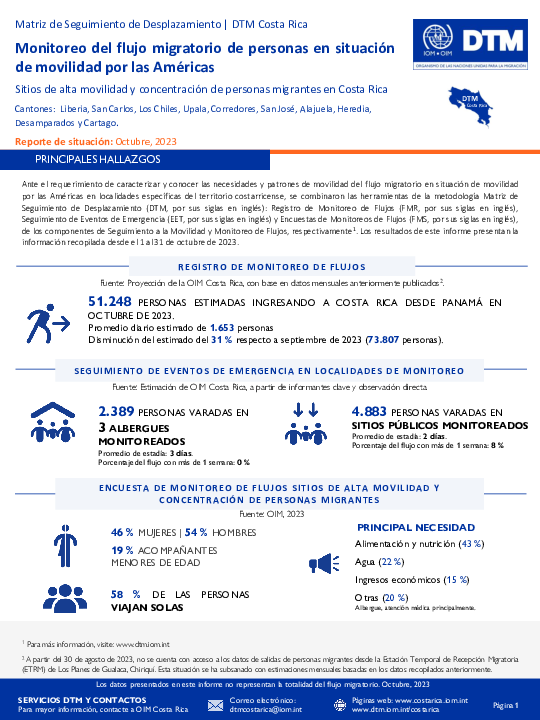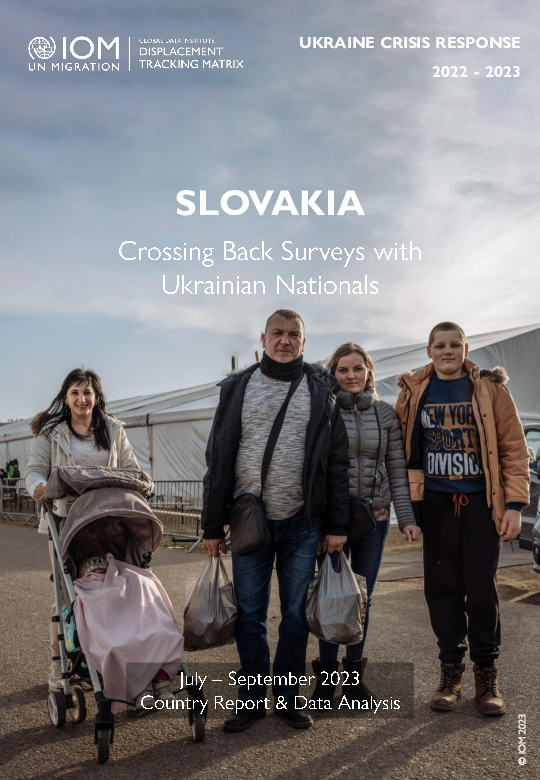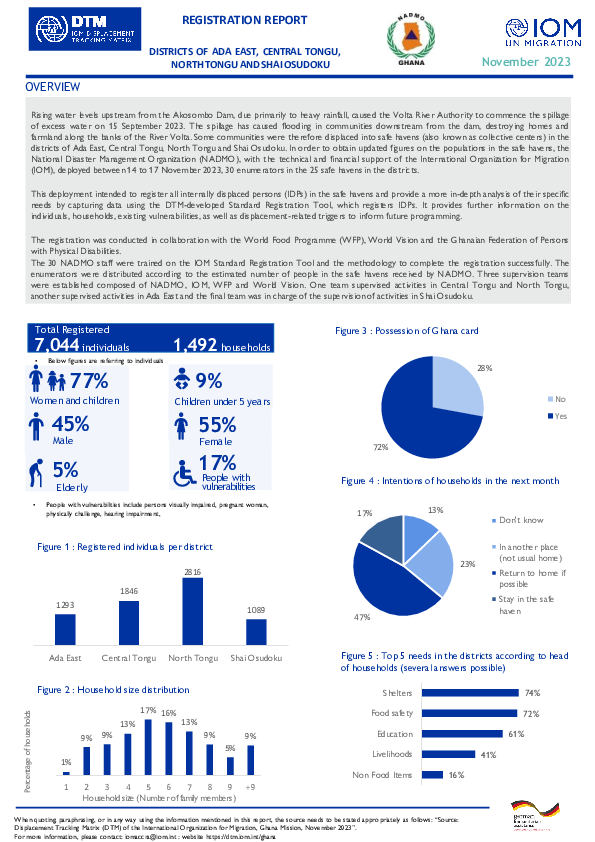-
Countries
-
Data and Analysis
-
Special Focus
-
Crisis Responses
Contact
dtmlebanon@iom.int
Location
Lebanon
Activity
- Mobility Tracking
- Baseline Assessment
Period Covered
Oct 10 2023 -Nov 21 2023
Since October 8 there has been an increase in cross-border incidents between Israel and Lebanon, resulting in the displacement of people both within the South and elsewhere within the country. Since October 10, the Displacement Tracking Matrix (DTM) has been conducting the daily monitoring of population movements. The objective of the exercise is to inform preparedness and response planning.
Population Groups
IDPs
Survey Methodology
Unit of Analysis Or Observation
Admin Area 2
Admin Area 3
Household
Individual
Type of Survey or Assessment
Key Informant
Keywords
Geographical Scope Full Coverage
Administrative boundaries with available data
The current dataset covers the following administrative boundaries
Contact
DTM Yemen, iomyemendtm@iom.int
Location
Yemen
Activity
- Mobility Tracking
- Event Tracking
Period Covered
Nov 19 2023 -Nov 25 2023
From 1 January to 25 November 2023, IOM Yemen DTM tracked 9,571 households (HH) (57,426 Individuals) who experienced displacement at least once.
Between 19 and 25 November 2023, IOM Yemen DTM tracked 42 households (252 individuals) displaced at least once. The majority of people moved into/within the following governorates and districts:
- Al Hodeidah (26 HHs) – Al Khukhah (13 HHs), and Hays (13 HHs) districts. Most displacements in the governorate were internal.
- Ma’rib (10 HHs), Ma’rib City (7 HHs), and Ma’rib (3 HHs) districts. Most displacements in the governorate originated from Al Hodeidah and Ma’rib.
- Ta’iz (5 HHs) – Al Makha (5 HHs) district. Most displacements in the governorate originated from Al Hodeidah and Hadramawt.
- Al Hodiedah (31 HHs) - At Tuhayta (15 HHs), Al Jarrahi (9 HHs), Ad Durayhimi (3 HHs) districts.
- Ta’iz (5 HHs) – Maqbanah (3 HHs), At Taiziyah (2 HHs) districts.
- Ma’rib (2 HHs) – Madghal Al Jidan (2 HHs) district.
Population Groups
Survey Methodology
Unit of Analysis Or Observation
Type of Survey or Assessment
Keywords
Geographical Scope
Administrative boundaries with available data
The current dataset covers the following administrative boundaries

Contact
DTM Somalia, IOMSomaliaDTM@iom.int
Language
English
Location
Somalia
Period Covered
Nov 12 2023
Nov 18 2023
Activity
- Mobility Tracking
- Event Tracking
In response to the Somalia’s severe drought beginning in November 2021, DTM Somalia launched an Emergency Trends Tracking (ETT) tool first in Gedo and Bay regions in 2022, and subsequently in Hiraan, Banadir and Middle Shabelle regions in 2023 to monitor drought related displacement trends and hotspots in support of operational planning. However, during the first half of 2023, conflict and flooding displacements have been significant. Therefore, DTM restructured its ETT tool to capture multi-shock displacements (drought, flood, conflict and other) from October 2023.
ETT is a crisis-based tool that tracks sudden displacement triggered by specific events or emerging crises. The objective of ETT is to help prioritize humanitarian response and to enable partners to deliver rapid assistance.

Contact
DTMCostaRica@iom.int
Language
English
Location
Costa Rica
Period Covered
Oct 01 2023
Oct 30 2023
Activity
- Flow Monitoring
- Mobility Tracking
- Event Tracking
Cantons: Liberia, Los Chiles, San Carlos, Heredia, Alajuela, Cartago, San José y Corredores.
Costa Rica, like the other countries in the Central American region, has been characterized as a migratory corridor for people who transit by land from the south to the north of America and whose destination is the countries in the north of the continent. This flow on the move through the Americas is mainly made up of people from the Bolivarian Republic of Venezuela, Cuba, Haiti, Ecuador, as well as people from other countries in South America, Africa and Asia.
According to estimations from IOM Costa Rica, during October 51,248 people entered the country, an average of 1,653 people per day and estimating a decrease of 31% compared to September 2023. In addition, 2,389 people stranded in the monitored shelters were identified and 4,883 people stranded in the public places visited.

Contact
DTMCostaRica@iom.int
Language
Spanish
Location
Costa Rica
Period Covered
Oct 01 2023
Oct 30 2023
Activity
- Flow Monitoring
- Mobility Tracking
- Event Tracking
Cantones: Liberia, Los Chiles, San Carlos, Heredia, Alajuela, Cartago, San José y Corredores.
Costa Rica, al igual que los demás países de la región centroamericana, se ha caracterizado por ser un corredor migratorio para personas que transitan de manera terrestre desde el sur hasta el norte de América y que tienen como destino los países del norte del continente. Este flujo en situación de movilidad por las Américas se encuentra compuesto principalmente por personas de la República Bolivariana de Venezuela, Cuba, Haití, Ecuador, así como personas provenientes de otros países de Suramérica, África y Asia.
Según estimaciones de la OIM Costa Rica, durante octubre ingresaron al país 51.248 personas, un promedio de 1.653 personas por día y estimando una disminución de un 31% con respecto a setiembre de 2023. Además, se identificaron 2.389 personas varadas en los albergues monitoreados y 4.883 personas varadas en los sitios públicos visitados.

Contact
DTM Europe, DTMMediterranean@iom.int
Language
English
Location
Slovakia
Period Covered
Jul 01 2023
Sep 30 2023
Activity
- Survey
- Return Intention
Main findings
- Top countries of stay: Slovakia (80%), Czech Republic (4%), Austria (3%), Germany (2%), Ireland (1%) United Kingdom (1%).
- Intentions: 53% going for a short visit, 39% plan to stay in Ukraine (prospective returnees), and 8% undecided.
- Top needs*: health services (48%), medicines (31%), general information (26%), financial support (22%), language courses (22%), employment (21%). *more than one answer was possible (N=1,135).
- Destinations in Ukraine: 86% to the same oblast of origin, 14% to a different oblast in Ukraine: Zakarpatska (61%), Kyiv city (13%), Lvivska (10%).
- Transport to Ukraine: bus (82%), train (17%), car/minibus (1%).
- Travel mode: 66% alone and 34% in group.
- Experiences of discrimination: 13% experienced discrimination throughout their journey.
- Travelling with children: 68% of the respondents travelled with children aged less than 18 years

Contact
iomaccra@iom.int
Language
English
Location
Ghana
Period Covered
Nov 14 2023
Nov 17 2023
Activity
- Registration
Rising water levels upstream from the Akosombo Dam, due primarily to heavy rainfall, caused the Volta River Authority to commence the spillage of excess water on 15 September 2023. The spillage has caused flooding in communities downstream from the dam, destroying homes and farmland along the banks of the River Volta. Some communities were therefore displaced into safe havens (also known as collective centers) in the districts of Ada East, Central Tongu, North Tongu and Shai Osudoku. In order to obtain updated figures on the populations in the safe havens, the National Disaster Management Organization (NADMO), with the technical and financial support of the International Organization for Migration (IOM), deployed between 14 to 17 November 2023, 30 enumerators in the 25 safe havens in the districts.
This deployment intended to register all internally displaced persons (IDPs) in the safe havens and provide a more in-depth analysis of their specific needs by capturing data using the DTM-developed Standard Registration Tool, which registers IDPs. It provides further information on the individuals, households, existing vulnerabilities, as well as displacement-related triggers to inform future programming.
The registration was conducted in collaboration with the World Food Programme (WFP), World Vision and the Ghanaian Federation of Persons with Physical Disabilities.
The 30 NADMO staff were trained on the IOM Standard Registration Tool and the methodology to complete the registration successfully. The enumerators were distributed according to the estimated number of people in the safe havens received by NADMO. Three supervision teams were established composed of NADMO, IOM, WFP and World Vision. One team supervised activities in Central Tongu and North Tongu, another supervised activities in Ada East and the final team was in charge of the supervision of activities in Shai Osudoku.

Contact
Daniel Tagoe: DTagoe@iom.int
Language
English
Location
Ghana
Period Covered
Oct 19 2023
Nov 22 2023
Activity
- Site Assessment
The Volta Region in Ghana has experienced heavy rains and high inflows of water to the Akosombo and Kpong dam reservoir, leading to severe flooding that has displaced 39,333 people in 9 districts. Infrastructure, crops, and shelters have been damaged, and access to essential services has been disrupted. Between 19th and 22nd October 2023, the Inter-Agency Emergencies Working Group in Ghana (IAEWG) conducted a rapid needs assessments due to the floods in collaboration with the National Disaster Management Organization (NADMO). The assessment focused on 2 districts (Central Tongu and North Tongu) and specifically in 9 safe havens (collective centers hosting Internally Displaced Persons, IDPs). Both districts have been severely impacted by the floods and currently host 75 per cent of the displaced population. The assessment team assessed 4 collective centers in Central Tongu (New Bakpa, Afetorgborkope, Farm Institute, Lunchtorkor) and 5 in North Tongu (Mepe Presby Junior High School [JHS], Mepe JHS, Mepe Presby Primary School, RC Primary school, Saint kizito). Collective centers were selected in coordination with NADMO based on two criterias: the accessibility and the highest number of IDPs.
Prior to the assessment in the collective centers, interviews have been conducted with NADMO regional directors in order to get an overview of the situation in the 9 districts. Through a network of 9 key informants and NADMO local field agents, in close coordination with IAWGE and local authorities on the ground, 9 interviews have been conducted, as well as 29 focus group discussions (FDGs) with men, women, boys and girls, including person with disabilities. The focus groups discussion methodology has been validated by the participants of the Rapid Needs Assessments. FDGs with children has been done with the presence of specialized agency. The goal of the Rapid Needs Assessment was to identify needs of the displaced population, and to identify urgent humanitarian response to the floods.
This dashboard presents the results of the Rapid Needs Assessment on health, WASH, education, protection and mental health of the displaced populations living in collective centers in Volta after the flooding.

Contact
DTM DRC, iomdrcdtm@iom.int
Language
French
Location
Democratic Republic of the Congo
Period Covered
Oct 27 2023
Nov 19 2023
Activity
- Event Tracking
Depuis le début de la crise, l'OIM, par le biais de la DTM continue à mener une série d'évaluations rapides, y compris le suivi des urgences (EET/ERM), l'analyse des crises et enregistrement avec priorité de répondre aux besoins immédiats d'information en vue de comprendre la dynamique des déplacements et les besoins. Ce rapport présente les résultats des évaluations menées dans les différentes zones de déplacement et de retour du 27 octobre au 19 novembre 2023.
Les données sur les déplacements recueillies dans le cadre de cette dixième analyse de crise montrent une nouvelle augmentation du nombre de personnes déplacées par rapport à la publication précédente. Le nombre de déplacés internes est passé de 908 920 à 1 076 261 personnes au 19 novembre 2023, soit une augmentation de 167 341 individus ou 18 pour cent. Cette augmentation est due aux multiples attaques, notamment celle qui a touché les territoires de Rutshuru, Masisi et Nyiragongo

Contact
DTM Niger, DTMNiger@iom.int
Language
French
Location
Niger
Period Covered
May 01 2023
May 15 2023
Activity
- Survey
Dans les communautés de Tahoua et de Zinder, au Niger, la migration est perçue comme un phénomène complexe et multidimensionnel. Pour les communautés locales, la migration est souvent considérée à la fois comme une opportunité et un défi. D'une part, elle est perçue comme une possibilité d'améliorer les conditions de vie, d'accéder à de meilleures opportunités économiques et de se connecter avec des réseaux internationaux. D'autre part, la migration peut également être perçue comme une perte de ressources humaines, notamment de la jeunesse qualifiée qui choisit de partir à la recherche de meilleures perspectives ailleurs.
Du point de vue des migrant.e.s, le voyage migratoire est souvent entrepris avec l'espoir d'une vie meilleure, d'une sécurité économique et d'une stabilité sociale. Pour beaucoup, la migration est un choix stratégique pour répondre aux défis économiques et aux difficultés rencontrées dans leur région d'origine. Ils voient la migration comme une occasion de s'épanouir personnellement, de soutenir financièrement leur famille et d'acquérir de nouvelles compétences et connaissances.
Cependant, le voyage migratoire comporte également des risques et des incertitudes. Les migrant.e.s peuvent faire face à des conditions de voyage difficiles, à des situations d'exploitation et à des violations des droits humains. Malgré ces défis, beaucoup de migrants continuent à prendre la décision de partir, motivés par l'espoir d'un avenir meilleur.
Dans l'ensemble, la perception de la migration par les communautés de Tahoua et de Zinder est ambivalente, mêlant à la fois des espoirs et des inquiétudes. Les migrant.e.s, quant à eux, entreprennent le voyage migratoire en quête de nouvelles opportunités et d’une vie meilleure, tout en faisant face à des défis et des risques. Comprendre ces perspectives est essentiel pour élaborer des politiques et des interventions qui répondent aux besoins des communautés et des migrant.e.s, en favorisant le développement durable et en garantissant la protection des droits de l’homme.